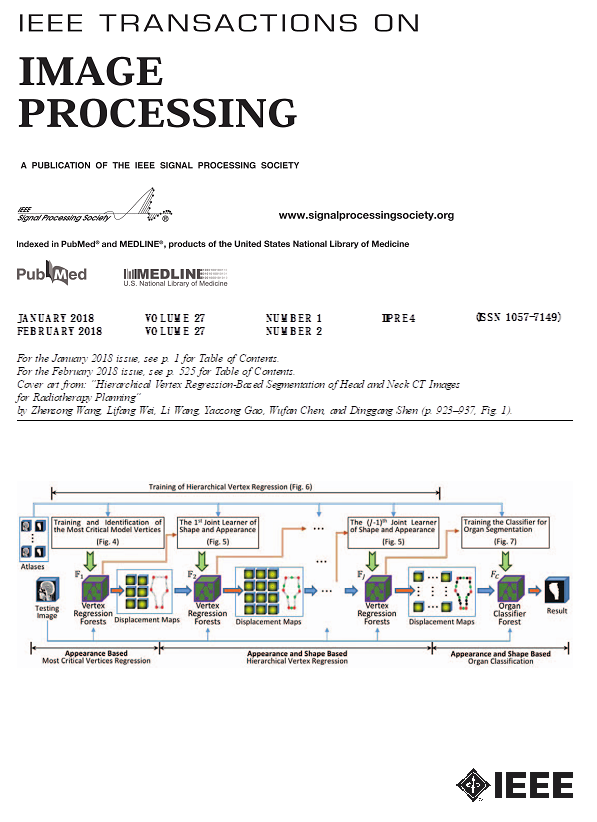Waterloo Exploration Database: New Challenges for Image Quality Assessment Models
IF 10.8
1区 计算机科学
Q1 COMPUTER SCIENCE, ARTIFICIAL INTELLIGENCE
引用次数: 459
Abstract
The great content diversity of real-world digital images poses a grand challenge to image quality assessment (IQA) models, which are traditionally designed and validated on a handful of commonly used IQA databases with very limited content variation. To test the generalization capability and to facilitate the wide usage of IQA techniques in real-world applications, we establish a large-scale database named the Waterloo Exploration Database, which in its current state contains 4744 pristine natural images and 94 880 distorted images created from them. Instead of collecting the mean opinion score for each image via subjective testing, which is extremely difficult if not impossible, we present three alternative test criteria to evaluate the performance of IQA models, namely, the pristine/distorted image discriminability test, the listwise ranking consistency test, and the pairwise preference consistency test (P-test). We compare 20 well-known IQA models using the proposed criteria, which not only provide a stronger test in a more challenging testing environment for existing models, but also demonstrate the additional benefits of using the proposed database. For example, in the P-test, even for the best performing no-reference IQA model, more than 6 million failure cases against the model are “discovered” automatically out of over 1 billion test pairs. Furthermore, we discuss how the new database may be exploited using innovative approaches in the future, to reveal the weaknesses of existing IQA models, to provide insights on how to improve the models, and to shed light on how the next-generation IQA models may be developed. The database and codes are made publicly available at: https://ece.uwaterloo.ca/~k29ma/exploration/.滑铁卢探索数据库:图像质量评估模型的新挑战
现实世界数字图像的巨大内容多样性对图像质量评估(IQA)模型提出了巨大的挑战,传统的图像质量评估模型是在少数常用的IQA数据库上设计和验证的,这些数据库的内容变化非常有限。为了测试IQA技术的泛化能力,并促进IQA技术在实际应用中的广泛应用,我们建立了一个名为Waterloo Exploration database的大型数据库,该数据库目前包含4744张原始自然图像和94,880张由原始自然图像创建的失真图像。我们没有通过主观测试来收集每张图像的平均意见得分,这是非常困难的,如果不是不可能的话,我们提出了三个替代测试标准来评估IQA模型的性能,即原始/扭曲图像的可判别性测试,列表排序一致性测试和成对偏好一致性测试(P-test)。我们使用建议的标准比较了20个知名的IQA模型,这些模型不仅在更具挑战性的测试环境中为现有模型提供了更强大的测试,而且还展示了使用建议的数据库的额外好处。例如,在p检验中,即使对于性能最好的无参考IQA模型,也会在超过10亿个测试对中自动“发现”超过600万个与模型相关的失败案例。此外,我们还讨论了未来如何使用创新方法来利用新数据库,以揭示现有IQA模型的弱点,提供如何改进模型的见解,并阐明如何开发下一代IQA模型。数据库和代码可在https://ece.uwaterloo.ca/~k29ma/exploration/上公开获取。
本文章由计算机程序翻译,如有差异,请以英文原文为准。
求助全文
约1分钟内获得全文
求助全文
来源期刊

IEEE Transactions on Image Processing
工程技术-工程:电子与电气
CiteScore
20.90
自引率
6.60%
发文量
774
审稿时长
7.6 months
期刊介绍:
The IEEE Transactions on Image Processing delves into groundbreaking theories, algorithms, and structures concerning the generation, acquisition, manipulation, transmission, scrutiny, and presentation of images, video, and multidimensional signals across diverse applications. Topics span mathematical, statistical, and perceptual aspects, encompassing modeling, representation, formation, coding, filtering, enhancement, restoration, rendering, halftoning, search, and analysis of images, video, and multidimensional signals. Pertinent applications range from image and video communications to electronic imaging, biomedical imaging, image and video systems, and remote sensing.
 求助内容:
求助内容: 应助结果提醒方式:
应助结果提醒方式:


